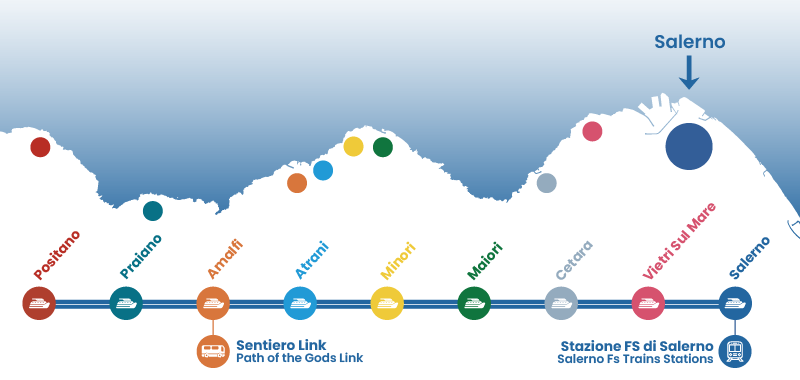Salerno
The gateway to the Amalfi Coast. A vibrant city to explore, rich in history, art, and natural beauty.
Salerno, the strategic hub for exploring the Amalfi Coast
The second-largest town of Campania for inhabitants, Salerno, overlooks the Gulf of the Tyrrhenian Sea of the same name, and it is located in a strategic position halfway between the Amalfi Coast and the Piana del Sele.
It is a lively port city that has been able to renew and improve over the years, giving life to a proper urban revolution that changed the face of the city and made it an important hub for connection with Naples, Rome and the major cities of the south of Italy.
From its touristic port Masuccio which is located in Piazza della Concordia, very close to train station, there are daily connections to all the most famous places on the Amalfi Coast with a port (Amalfi, Positano, Cetara, Vietri sul Mare, Minori and Maiori).

The city, founded by the Etruscans in the 6th century B.C., has undergone various dominations over the centuries that have shaped both its history and architecture. During the Middle Ages, Salerno became a melting pot of culture, religion, and people, evolving into an open and innovative city. Notably, in the 11th century, it was here that the first Medical School in all of Europe was established, founded by four masters of different nationalities: an Arab, a Jew, a Latin, and a Greek.
In recent years, significant restoration work has transformed the historic center, the core of the old city, into one of the most beautiful in Italy. Characteristic narrow alleys and medieval passages create a unique atmosphere, offering a glimpse into the true spirit of the city. The area is home to numerous Lombard and Norman-era buildings and churches, while the entire center is crisscrossed by Via dei Mercanti, the ancient Drapperia, one of the city's oldest streets and a long-standing hub for shopping in Salerno.
What to see and what to do in Salerno?
\1
The Cathedral of Salerno
Known as the Cathedral of San Matteo, it houses the remains of the city's patron saint. It dates back to 1084 and was inaugurated following the consecration of Pope Gregory VII. Renovated several times as a result of subsidence and earthquakes, it was definitively rearranged in its original aspect after the strong earthquake of 1688. Notable highlights include the Church's bell tower, featuring 12th-century Arab architectural style; the Crypt, fully adorned with frescoes depicting scenes from the Gospel of Matthew; and the Treasury Chapel where the silver statues of the saint are preserved.
\2
The Lungomare Trieste
It connects the commercial port to the Masuccio tourist harbor and is the ideal place for a pleasant stroll while admiring the breathtaking view of the Gulf of Salerno. It's also the ideal route to reach Piazza della Concordia, where ferries depart for the main towns of the Amalfi Coast.
\3
The Medieval Arechi Castle
Ancient defensive fortress dating back to the 6th century, the Arechi Castle was originally built in the Byzantine period and later expanded by the Normans. Its most distinctive feature is the crenelated wall bastion. Today, it hosts the Natural Park, a Multimedia Museum, the Provincial Wine Cellar of Salerno, and the Medieval Museum, which preserves ceramics, glassware, metal objects, and coins from excavations carried out on the site.
\4
The Medieval Aqueduct
Built in the 9th century to supply water to the Monastery of San Benedetto, it features a pointed arch, known as the "Devil's Bridge". According to legend, it was constructed in just one night with the help of demons.
\5
Via dei Mercanti
It is the most famous street in the heart of Salerno, as well as the hub of commerce and shopping of the town. Along its path, you'll find numerous churches: the Church of Santissimo Crocifisso, the Church of San Gregorio, the Church of San Giorgio and the Church of San Pietro a Corte; It also hosts several museums: the Provincial Archaeological Museum, the Diocesan Museum and the significant Didactic Museum of the Salerno Medical School. Noteworthy palaces include Palazzo Pinto, home to the Provincial Art Gallery, and Palazzo Carrara. Here you can see the beautiful Fontana dei pesci (fish fountain), designed by Vanvitelli, the architect of the Royal Palace of Caserta.
\6
Luci d'Artista: Salerno's Spectacular Christmas Lights Event
From mid-November each year, the entire city of Salerno transforms into the stage for a spectacular Christmas light event that attracts hundreds of thousands of visitors: Luci d'Artista.
Streets, parks, squares and gardens are illuminated by stunning contemporary art installations, made up of thousands of LED lights. Each year, these artworks explore a different theme, ranging from the sea and flowers to fairy tale characters, elements of the universe, mythological figures, and religious icons.





